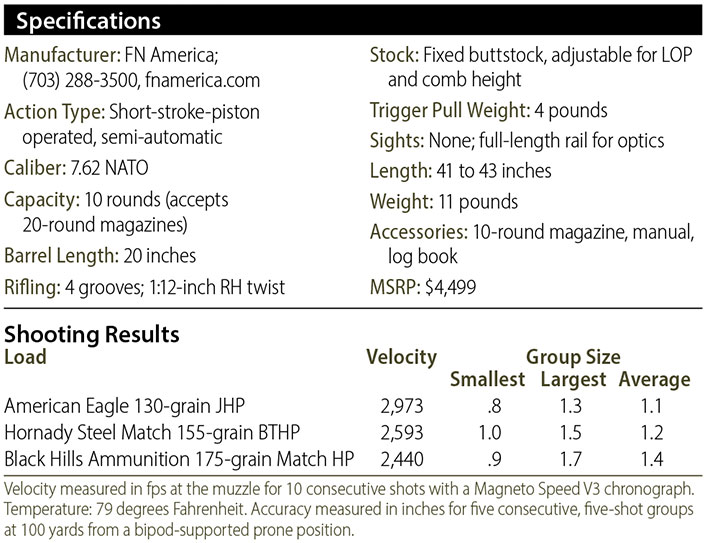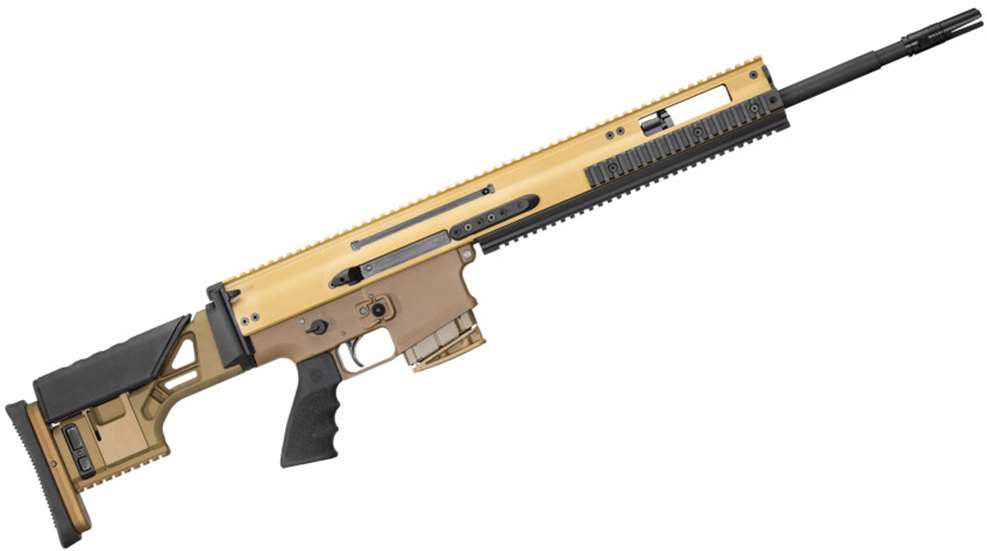
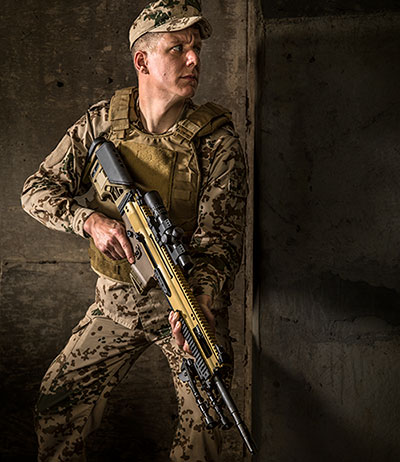 Shortly after the turn of the 21st century, the United States Special Operations Command (USSOCOM) began receiving requests for a new “Combat Assault Rifle” from SOF troops who were actively engaged in combat. I was in the thick of both the literal and figurative battles at that time. Between overseas tours where I stayed busy as an SOF sniper, I fought the war of weapons modernization on the home front. While my unit handled most of our requirements internally, we sometimes participated in SOCOM weapons efforts in both advisory and test roles. Among the critical needs being articulated at the time was the request for a larger-caliber carbine that would provide greater effective ranges than standard M4-series carbines. Fabrique Nationale (FN) was one of several companies to provide submissions to USSOCOM’s new SCAR program, one component of which sought to answer the larger-caliber carbine need. After initial testing and partial fielding in limited numbers, FN’s 5.56 NATO MK16 and 7.62 NATO MK17 SCAR rifles (along with the company’s MK13 Enhanced Grenade Launcher Module) were chosen for full fielding within SOCOM and subsequently deployed into combat theaters.
Shortly after the turn of the 21st century, the United States Special Operations Command (USSOCOM) began receiving requests for a new “Combat Assault Rifle” from SOF troops who were actively engaged in combat. I was in the thick of both the literal and figurative battles at that time. Between overseas tours where I stayed busy as an SOF sniper, I fought the war of weapons modernization on the home front. While my unit handled most of our requirements internally, we sometimes participated in SOCOM weapons efforts in both advisory and test roles. Among the critical needs being articulated at the time was the request for a larger-caliber carbine that would provide greater effective ranges than standard M4-series carbines. Fabrique Nationale (FN) was one of several companies to provide submissions to USSOCOM’s new SCAR program, one component of which sought to answer the larger-caliber carbine need. After initial testing and partial fielding in limited numbers, FN’s 5.56 NATO MK16 and 7.62 NATO MK17 SCAR rifles (along with the company’s MK13 Enhanced Grenade Launcher Module) were chosen for full fielding within SOCOM and subsequently deployed into combat theaters.
I became familiar with both rifles during the last couple years of my Army career while managing weapons R&D and fielding efforts for my own unit. Although we ultimately chose different solutions for our needs, I spent a fair amount of time with the larger MK17 during early testing. Once the usual new-gun kinks were smoothed out, the finished product was a balanced, lightweight carbine that fired a hard-hitting, full-bore cartridge. My experience since has been that the commercial equivalent to the MK17—the SCAR 17—is extremely reliable and possesses above-average, out-of-the-box accuracy for a light .30-caliber rifle. A dedicated group of FN SCAR fans apparently agrees, and will be happy to hear that the newest member of the “SCAR Heavy” family has arrived in the form of the SCAR 20S.
The FN America SCAR 20S is actually a close sibling to the military-issue SCAR 20 SSR. The SSR, or sniper support rifle, is neither a sniper rifle nor a general-purpose battle rifle. Rather, its performance is in the realm of a designated-marksman-type long gun, providing additional range, accuracy and payload delivery over standard-issue carbines. According to the 20S’s manual, it was developed as a “…direct result of the U.S. Military’s search for a modular battle rifle that is easy to use and extremely reliable.” The chief differences between the SCAR 20S and the SSR are color variations in their flat dark earth finishes, a lack of iron sights on the civilian version and different muzzle devices. The chief upgrades that the SCAR 20S has over the SCAR 17 are a longer/heavier barrel, a match trigger, a fixed buttstock designed for prone use and a longer receiver fore-end.
The SCAR 20S uses the same dependable short-stroke piston-operating system relied upon by the rest of the SCAR family, and also shares the SCAR 17’s polymer trigger module (housing) and internal receiver components. The SCAR 20S’s anodized (FDE) monolithic receiver provides a full 22 inches (or 56 slots) of continuous rail space on top. Additional mounting space is provided by bolted-on, 8-inch rails on each side of the receiver’s fore-end and an 11.5-inch rail at the 6-o’clock position. Machined-aluminum sling-attachment loops are on either side of the fore-end’s leading edge, as well as at the receiver/stock junction, with two loops on the left side and a single loop on the right. The bolted-on short rails and fixed sling loops are definitely built with the rigors of ground combat in mind. What they lack in “QD-ness” they make up for in bomb-proofness.”
The SCAR 20S’s adjustable gas regulator is housed within the extended handguard. Access to the forward-facing adjustment lever is achieved through generous access cuts in either side of the freefloat section. Two positions modulate gas flow to the piston using ports measuring .106 and .104 inch. The included manual states that the gas regulator should always be set at the 12-o’clock position, which aligns the larger aperture with the barrel’s gas port. The lever is finger adjustable, but just like the barrel and remainder of the gas block, it will heat up during firing. Though not stated as such in the manual, FN literature for the SCAR’s principle of operation indicates that the smaller gas port is for use when a sound suppressor is attached, which is consistent with the company’s military models. The 20S is only available from the factory with a three-prong flash hider, so you will have to retrofit the rifle if you plan to mount a can. The 20-inch, cold-hammer-forged and chrome-lined barrel is threaded to the common 5⁄8x24 tpi, so many options for other muzzle devices exist.
Speaking of the barrel, FN stayed with the SCAR 17’s 1:12-inch twist rate on this rifle. The company’s literature makes clear that the SCAR 20S is marketed specifically as a long-range tool, which leaves me wondering why a tighter twist is not offered for the U.S. market. The move toward substantially heavier, 175-grain-plus .30-caliber projectiles for long-range shooting began more than two decades ago as snipers and precision shooters sought to reach farther targets without giving up accuracy. However, FN’s commercial marketing is focused on offering consumers products that are as close to their military counterparts as possible, so that places the 1:12-inch-twist barrel into some context. FN purists can have a rifle very close to its martial sibling, since the SCAR 20S uses the same barrel as the SCAR 20SSR. It may or may not be a coincidence that the barrels used in FN’s widely proliferated MAG-58 machine gun family—including our own M240 variants—also carry a 1:12-inch twist. While 145- to 150-grain FMJ projectiles are still the standard M80 ball/7.62 NATO belt-fed-machine-gun load and stabilize well at this twist rate, they are not exactly known for consistent accuracy. Fortunately, FN barrels are well-regarded for their quality and durability, which is why the company’s 5.56 NATO barrel blanks are stamped with the names of several well-known AR-barrel “manufacturers” here in the U.S.
At the opposite end of the rifle, the SCAR 20S’s fixed stock is well-designed for its precision mission. Gone are the folding hinge and cheek hump common to shorter SCAR rifles, replaced by a skeletonized-aluminum unit that is finger-adjustable for length-of-pull and comb height. Push-buttons provide 10 positions (1.75 inches total) in length options and eight positions (1.1 inches total) of height adjustment. Soft-rubber recoil and cheek pads make shooting enjoyable, and the adjustable cheek rest is left- and right-hand shooter friendly. An additional 3.75-inch rail section is bolted to the bottom of the stock for mounting a monopod. Rounding out the comfort suite is an AR-style, Hogue rubber pistol grip that may be changed out for any of the common AR aftermarket models.

The SCAR 20S’s controls are standard for the family. Polymer, ambidextrous selector levers rotate between “S” for safe and “1” for semi-automatic fire. Small screws fasten the levers to the selector’s drum, allowing lefties to swap them so the larger one is thumbable. An AR-style bolt catch is located on the rifle’s left side, below the reciprocating charging handle. Easily swap-ped from one side to the other, the charging handle provides excellent forward assistance in the event a bolt does not fully close. The ambi magazine release’s oversize buttons are positioned on either side of the mag well. Spring tension here is a perfect balance between facilitating rapid mag changes and preventing unintentional mag drops. The SCAR 20S uses the same FN-style, 10- and 20-round magazines as the SCAR 17.
FN chose a proven trigger for the SCAR 20S in the form of Geissele Automatics’ Super SCAR, two-stage, non-adjustable match unit. I have installed this trigger in several SCAR 16 and 17 rifles over the years and find it to be an excellent aid in squeezing the most out of this platform’s accuracy potential. The Super SCAR’s pull weight falls between Geissele’s popular 3.5-pound SSA-E and 4.5-pound SSA match triggers, and has the same clean break.

Fieldstripping the SCAR 20S is accomplished in the same manner as the rest of the SCAR family, but with one minor difference. Since the 20-inch rifle’s fore-end extends beyond the gas block, access for disassembling the piston system comes through the same windows used to adjust it. Finger space is limited in there, but I found that removing the regulator and piston was simple. The process is explained clearly in the well-written manual. One point from the manual worth highlighting is that the short-stroke piston should not be oiled during maintenance. According to FN, doing so may negatively impact function or even damage the firearm. Field-stripping requires no tools beyond something to punch out the firing pin retaining pin—a cartridge tip works fine.
Barrel removal is not covered in the manual, but the process remains simple for the big SCAR. After clearing and field stripping the rifle, loosening the eight, captive T25 screws frees the barrel, gas block and the inner chassis from the rifle’s receiver and fore-end. This capability is useful for occasional, detailed maintenance and inspection. According to an FN representative, 62.5 inch-pounds is the proper torque for these screws when re-installing the
barrel assembly.
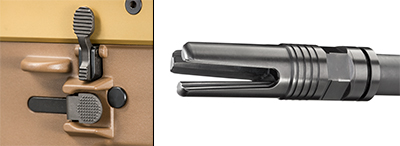
Since the SCAR 20S is patterned off of the SCAR SSR, I decided to test its accuracy in a manner appropriate to that style of rifle: bipod-supported in the prone position. I mounted a first-focal-plane optic with an enhanced mil-based reticle, suitable for shooting out to the 1,000-yard mark. Normally, I would shoot heavier bullet weights in a rifle advertised as giving you the ability to “engage targets nearing 800 yards with ease,” but the SCAR 20S’s loosely twisted rifling called for a change to my usual methodology. In addition to the 175-grain Sierra MatchKings I usually lean on at longer ranges, I included very accurate 130-grain JHP and 155-grain BTHP loads into my test to cover more bases.
Shooting a rifle is where the sum of all features and components show their true value. The SCAR 20S did not disappoint in the reliability and “shootability” departments. It effortlessly digested 125 rounds of steel-cased match and brass-cased hunting and match loads during accuracy testing. The short-stroke piston-operating system combined with the 20-inch heavy barrel to effectively dampen felt recoil. Once I settled into a solid position, my
reticle’s center came right back on target after breaking each shot. The stock’s length-of-pull and comb adjustability made for a comfortable shooting session.
The results of my 100-yard accuracy testing did not show the sample rifle to be a tack-driver, but it did achieve sub-MOA accuracy using multiple factory loads. Doing so in field-practical shooting conditions is what I would expect a mid- to long-range support rifle to do. When compared to my previous SCAR 17 evaluation from May 2011—which used two of the same loads tested here—the bigger 20S edged past the lighter carbine’s overall performance by a small margin.
Overall, the SCAR 20S handled quite well. My only physical complaint is that the polymer brass deflector (bolted on just aft of the right-side ejection port) is too small to be useful for left-handed shooters. While shooting prone, every steel case and a handful of the brass cases landed on me. When I moved to the bench for chronograph work, every spent case hit me in the neck. We southpaws are experts in various forms of the hot-brass dance, but this was worse than anything I can recall.
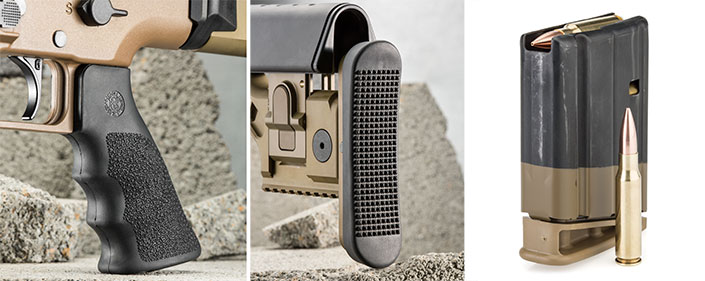
FN advertises the SCAR 20S as being “Perfectly calibrated for long-range precision fire,” so I followed up with another shooting session to see what kind of legs this rifle has. I focused on the American Eagle 130-grain JHP hunting ammunition that showed the best short-range accuracy (and highest velocity), as well as Black Hills Ammunition’s 175-grain load, which has proven itself to be a good performer at respectable distances. Once again, I shot from the same position using the same Nightforce optic mounted for the first test. After fine-tuning each load’s zero on paper at 100 yards, I shot at 8-inch steel squares at 200, 300 and 500 yards, followed by an 18-inch square at 600 yards and a 24-inch square at 800 yards. I plugged the rifle’s measured muzzle velocities and current atmospherics into the Strelok app on my Android phone to develop the needed elevation data.
The 130-grain load placed center hits on each steel target out to 600 yards with ease. At 800 yards, the low ballistic coefficient (G1-.263) for this projectile reared its ugly head. I burned through 10 rounds of the light load before finding center target as I tweaked the needed elevation hold and developed a workable wind formula. Once I cracked those codes, I could hit within 3 inches of the target’s center on demand. Unfortunately, this demand was high enough that I expended the rest the 130-grain ammo having a little too much fun at 800 yards. Considering that this projectile was designed to take predators at close range and winds were gusting from 5 to 15 mph at this distance, I was more than satisfied with the performance.
The 175-grain load was another story altogether. Starting at 300 yards, I noticed my impacts were erratic. Although the holes in my 100-yard targets showed no signs of wobbling, it appeared as if my groups were opening up exponentially as the distance increased. Although my chronograph data was right on the money at 300 yards, I had to reduce the velocity in my ballistic program from 2,440 fps to 2,300 fps in order to get useful elevation data at longer distances. Such a drastic change is a pretty good indicator that the bullets were wobbly and bleeding off more velocity than if they had been fully spin stabilized. I burned up most of my 175-grain ammo making holes in the air around my 500- and 600-yard targets. I managed a few erratic hits there, but failed to connect with the 800-yard target with the few rounds I had left.
I left the range with mixed feelings about this newest member of the SCAR family. On one hand, it is a well-balanced, sub-MOA-capable rifle that is very smooth to shoot on the bipod and which chewed through 210 rounds and multiple ammo types without fail. Then again, my test rifle did not do well with ammo that is normally well-suited for long-range precision.

Given FN’s focus on the precision-rifle portion of the shooting market, I am left wondering why the company did not offer an alternative long-range chambering option like 6.5 Creedmoor or other barrel-twist options at the very least. According to FN’s SCAR 20S product manager, the company currently “do[es] not have any updates on future twist rates or new calibers.” FN tends to release commercial versions of its military rifles in near-exact configurations, so it is reasonable to assume the company is knee-deep in current SOCOM efforts to field 6.5 Creedmoor rifles. If that is in fact the case, I expect to see a 6.5 Creedmoor option for the SCAR 20S at some point.
While inspecting the rifle, I noticed that the barrel was marked “7.62x51 mm,” but the owner’s manual stated that users should only use ammunition that meets “CIP or SAAMI specifications.” Since SAAMI’s specifications do not include 7.62 NATO, I assumed that .308 Win. was OK to shoot. A request for clarification from FN was not answered until I was done shooting. The feedback I got was: “FN can only recommend the user fire exactly what is marked on their barrel. In this case users should only fire 7.62x51 mm.” Many ignore the warning against firing .308 Win. cartridges in 7.62 NATO chambers. I carried several different .30-caliber sniper rifles in the Army and shot a metric ton of commercial .308 Win. ammo in military 7.62 NATO chambers with no ill effects. But, there is a lot of distance between 7.62 NATO and .308 Win. chamber pressures, so I cannot recommend the practice. That said, I used only .308 Win. in the test rifle. Although my expended brass showed no signs of pressure problems and function was flawless, if I had known the 20S truly had a 7.62 NATO chamber, that is what I would have shot.
Setting aside marketing quirks and a high price tag, the SCAR 20S will be a great rifle for SCAR fans, military-rifle collectors and military personnel who have developed an affinity for the SCAR 20 SSR. If my test sample is indicative of normal performance, the only concern owners will have is to find loads that are well-suited to the new SCAR’s barrel configuration.
